key BMW X3 3.0I 2005 E83 User Guide
[x] Cancel search | Manufacturer: BMW, Model Year: 2005, Model line: X3 3.0I, Model: BMW X3 3.0I 2005 E83Pages: 126, PDF Size: 4.65 MB
Page 28 of 126
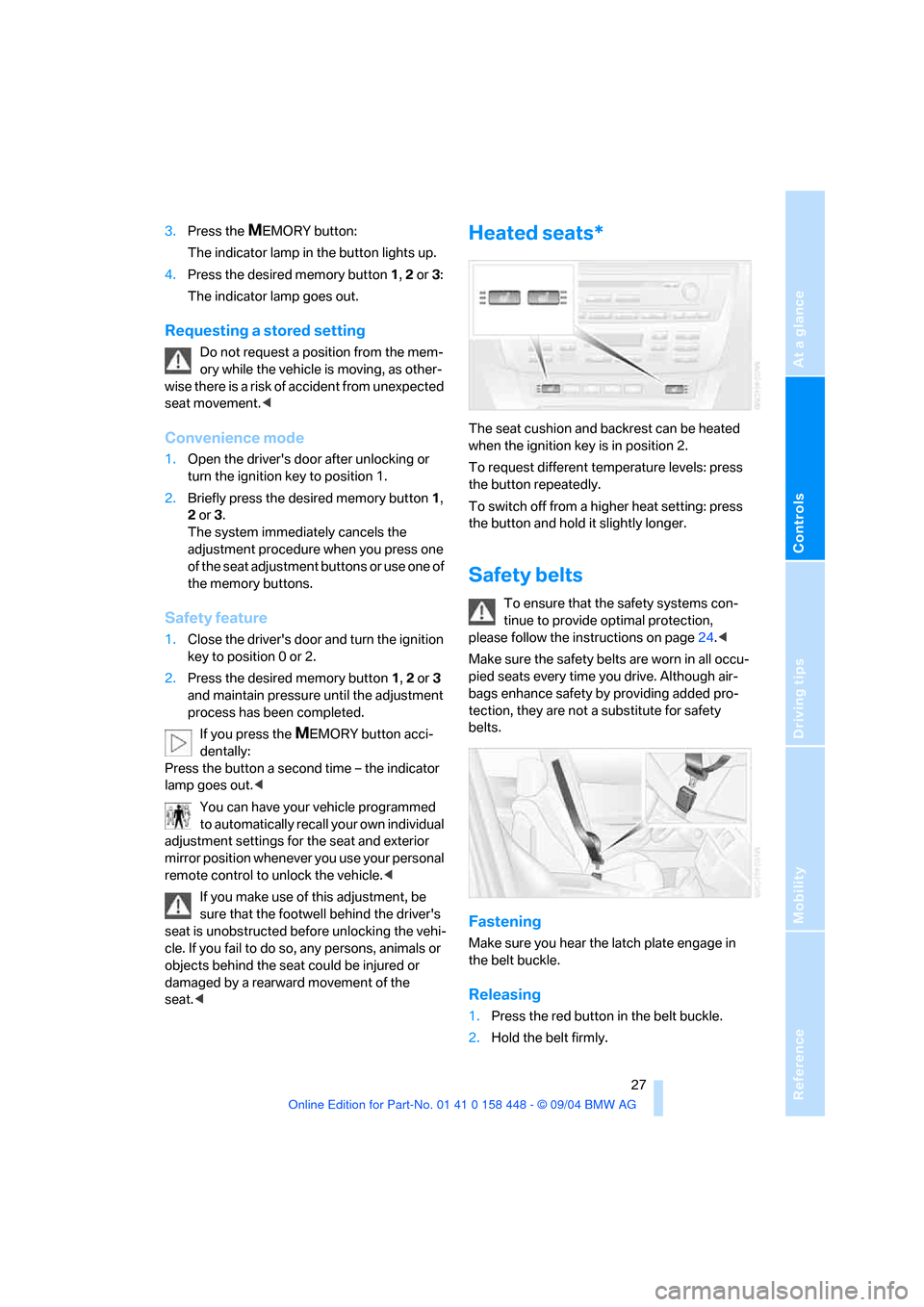
Reference
At a glance
Controls
Driving tips
Mobility
27
3.Press the MEMORY button:
The indicator lamp in the button lights up.
4.Press the desired memory button 1, 2 or3:
The indicator lamp goes out.
Requesting a stored setting
Do not request a position from the mem-
ory while the vehicle is moving, as other-
wise there is a risk of accident from unexpected
seat movement.<
Convenience mode
1.Open the driver's door after unlocking or
turn the ignition key to position 1.
2.Briefly press the desired memory button 1,
2 or3.
The system immediately cancels the
adjustment procedure when you press one
of the seat adjustment buttons or use one of
the memory buttons.
Safety feature
1.Close the driver's door and turn the ignition
key to position 0 or 2.
2.Press the desired memory button 1, 2 or3
and maintain pressure until the adjustment
process has been completed.
If you press the
MEMORY button acci-
dentally:
Press the button a second time – the indicator
lamp goes out.<
You can have your vehicle programmed
to automatically recall your own individual
adjustment settings for the seat and exterior
mirror position whenever you use your personal
remote control to unlock the vehicle.<
If you make use of this adjustment, be
sure that the footwell behind the driver's
seat is unobstructed before unlocking the vehi-
cle. If you fail to do so, any persons, animals or
objects behind the seat could be injured or
damaged by a rearward movement of the
seat.<
Heated seats*
The seat cushion and backrest can be heated
when the ignition key is in position 2.
To request different temperature levels: press
the button repeatedly.
To switch off from a higher heat setting: press
the button and hold it slightly longer.
Safety belts
To ensure that the safety systems con-
tinue to provide optimal protection,
please follow the instructions on page24.<
Make sure the safety belts are worn in all occu-
pied seats every time you drive. Although air-
bags enhance safety by providing added pro-
tection, they are not a substitute for safety
belts.
Fastening
Make sure you hear the latch plate engage in
the belt buckle.
Releasing
1.Press the red button in the belt buckle.
2.Hold the belt firmly.
Page 29 of 126
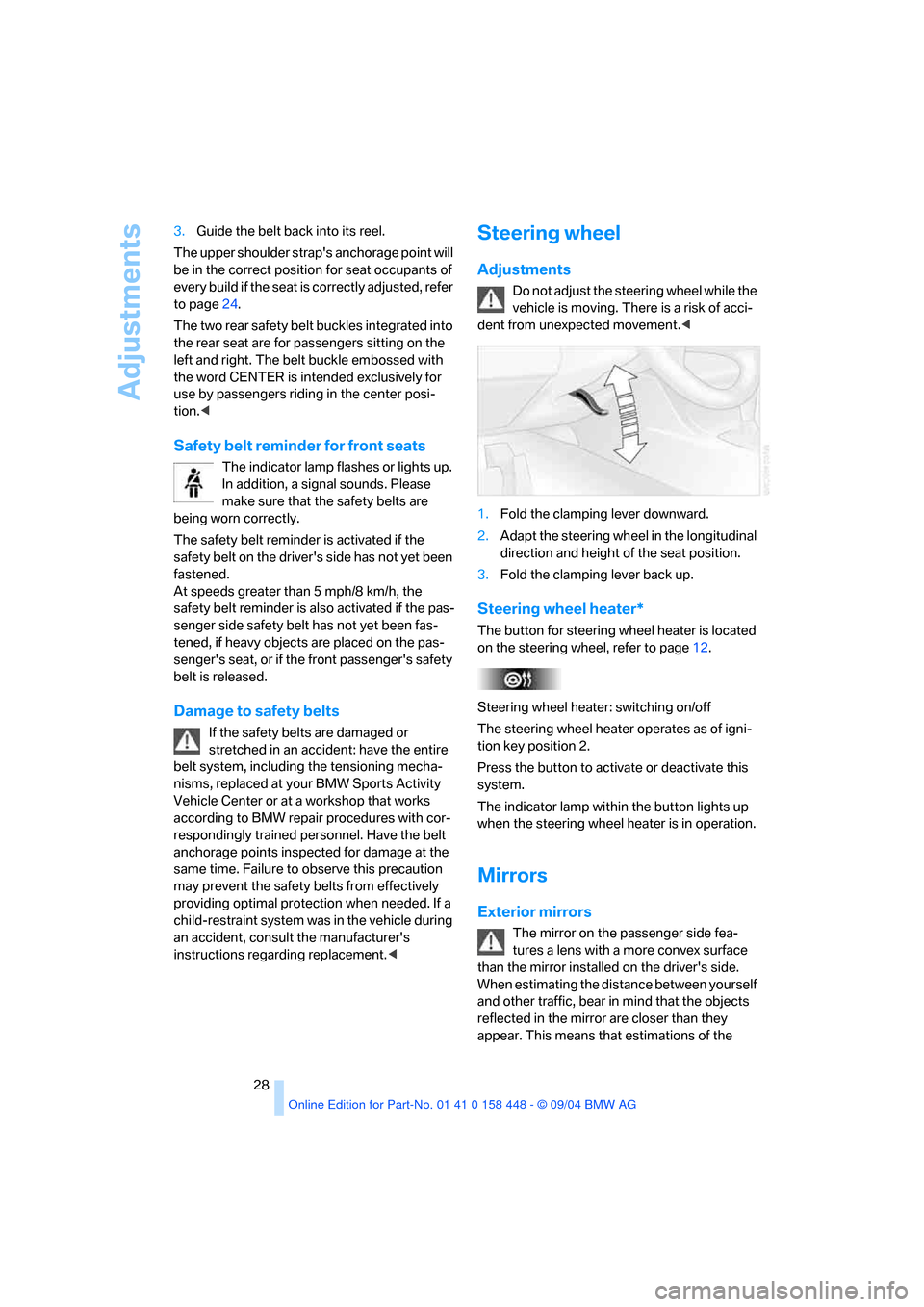
Adjustments
28 3.Guide the belt back into its reel.
The upper shoulder strap's anchorage point will
be in the correct position for seat occupants of
every build if the seat is correctly adjusted, refer
to page24.
The two rear safety belt buckles integrated into
the rear seat are for passengers sitting on the
left and right. The belt buckle embossed with
the word CENTER is intended exclusively for
use by passengers riding in the center posi-
tion.<
Safety belt reminder for front seats
The indicator lamp flashes or lights up.
In addition, a signal sounds. Please
make sure that the safety belts are
being worn correctly.
The safety belt reminder is activated if the
safety belt on the driver's side has not yet been
fastened.
At speeds greater than 5 mph/8 km/h, the
safety belt reminder is also activated if the pas-
senger side safety belt has not yet been fas-
tened, if heavy objects are placed on the pas-
senger's seat, or if the front passenger's safety
belt is released.
Damage to safety belts
If the safety belts are damaged or
stretched in an accident: have the entire
belt system, including the tensioning mecha-
nisms, replaced at your BMW Sports Activity
Vehicle Center or at a workshop that works
according to BMW repair procedures with cor-
respondingly trained personnel. Have the belt
anchorage points inspected for damage at the
same time. Failure to observe this precaution
may prevent the safety belts from effectively
providing optimal protection when needed. If a
child-restraint system was in the vehicle during
an accident, consult the manufacturer's
instructions regarding replacement.<
Steering wheel
Adjustments
Do not adjust the steering wheel while the
vehicle is moving. There is a risk of acci-
dent from unexpected movement.<
1.Fold the clamping lever downward.
2.Adapt the steering wheel in the longitudinal
direction and height of the seat position.
3.Fold the clamping lever back up.
Steering wheel heater*
The button for steering wheel heater is located
on the steering wheel, refer to page12.
Steering wheel heater: switching on/off
The steering wheel heater operates as of igni-
tion key position 2.
Press the button to activate or deactivate this
system.
The indicator lamp within the button lights up
when the steering wheel heater is in operation.
Mirrors
Exterior mirrors
The mirror on the passenger side fea-
tures a lens with a more convex surface
than the mirror installed on the driver's side.
When estimating the distance between yourself
and other traffic, bear in mind that the objects
reflected in the mirror are closer than they
appear. This means that estimations of the
Page 30 of 126
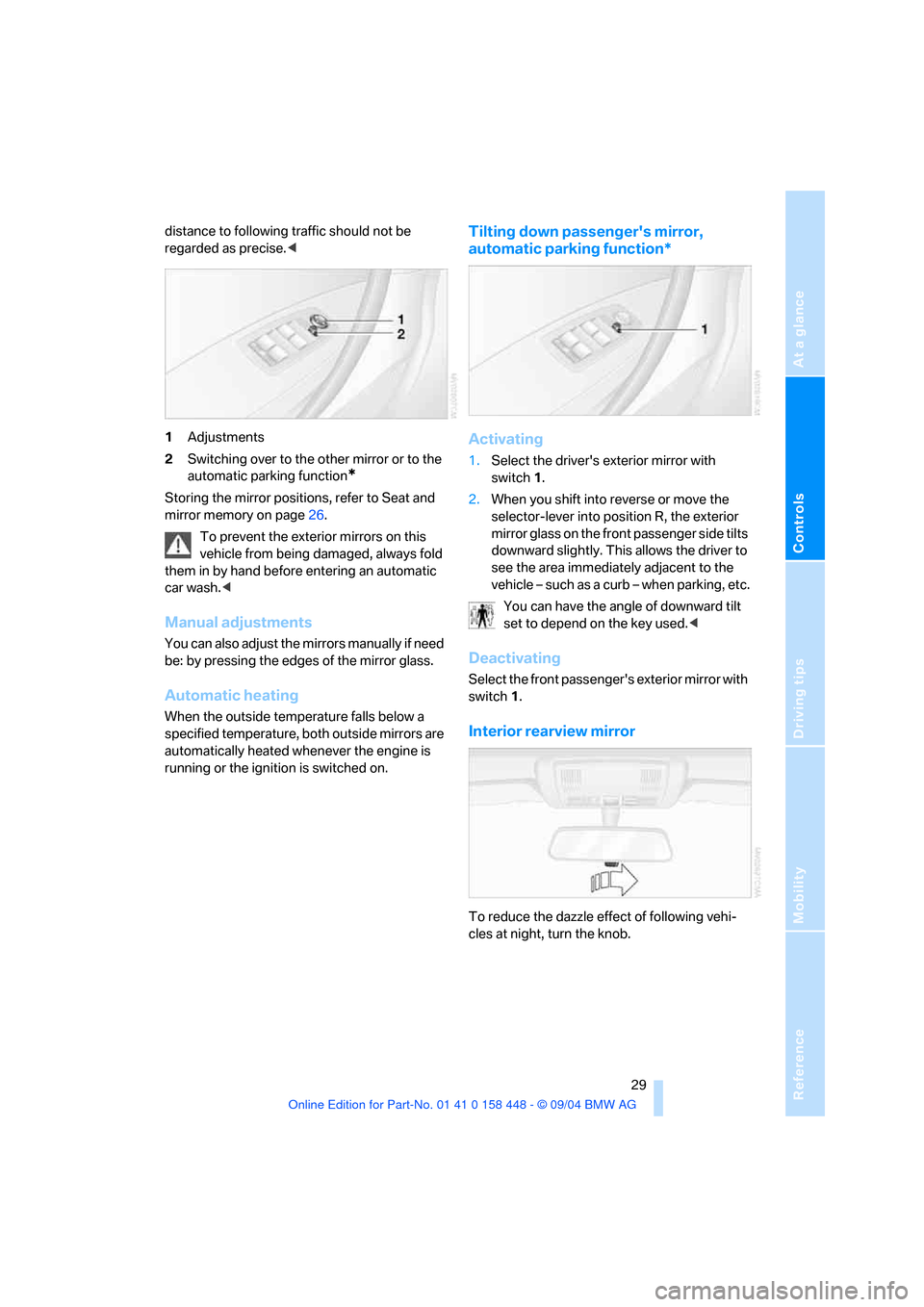
Reference
At a glance
Controls
Driving tips
Mobility
29
distance to following traffic should not be
regarded as precise.<
1Adjustments
2Switching over to the other mirror or to the
automatic parking function
*
Storing the mirror positions, refer to Seat and
mirror memory on page26.
To prevent the exterior mirrors on this
vehicle from being damaged, always fold
them in by hand before entering an automatic
car wash.<
Manual adjustments
You can also adjust the mirrors manually if need
be: by pressing the edges of the mirror glass.
Automatic heating
When the outside temperature falls below a
specified temperature, both outside mirrors are
automatically heated whenever the engine is
running or the ignition is switched on.
Tilting down passenger's mirror,
automatic parking function*
Activating
1.Select the driver's exterior mirror with
switch 1.
2.When you shift into reverse or move the
selector-lever into position R, the exterior
mirror glass on the front passenger side tilts
downward slightly. This allows the driver to
see the area immediately adjacent to the
vehicle – such as a curb – when parking, etc.
You can have the angle of downward tilt
set to depend on the key used.<
Deactivating
Select the front passenger's exterior mirror with
switch 1.
Interior rearview mirror
To reduce the dazzle effect of following vehi-
cles at night, turn the knob.
Page 31 of 126

Adjustments
30
Vehicle Memory, Key Memory
How the system functions
You have probably frequently wished that you
could configure individual functions of your
vehicle to reflect your own personal require-
ments. In developing your vehicle, BMW has
incorporated a number of options for personal
adjustment. You can have these programmed
at your BMW Sports Activity Vehicle Center.
There are vehicle-related and person-related
adjustments: Vehicle Memory and Key Mem-
ory. You can configure up to four different basic
adjustments for four different persons. The only
requirement is that each person uses his or her
own master key with remote control.
When your vehicle is unlocked with the remote
control, the vehicle recognizes the individual
user by means of a data exchange with the key,
and makes adjustments accordingly.
In order for you to distinguish between the mas-
ter keys with remote control, color-coded
decals are supplied together with the keys.
What the system can do
Your BMW Sports Activity Vehicle Center can
provide you with details on the capabilities of
the Vehicle Memory and Key Memory systems.
You will see this symbol throughout the
Owner's Manual. It is to remind you at
appropriate places of the settings that are avail-
able to you.<
Following configuration of memory func-
tions, vehicle operation may differ from
the description in the Owner's Manual. Should
you want to sell your BMW some day, please
remember to have the memory functions reset
to the factory default settings.<
Examples of Vehicle Memory functions
>Different acknowledgment signals to con-
firm locking/unlocking of the vehicle, refer
to page16.
>Activating/deactivating function for path-
way lighting, refer to page53.
>Activating/deactivating daytime driving
lamps, refer to page53.
>Setting measurement units for displays in
the instrument cluster for time, outside
temperature, distance driven and fuel con-
sumption, refer to page44.
>Active PDC Park Distance Control is indi-
cated by an acoustic sound signal when
reverse gear or selector lever position R is
engaged, refer to page46.
>The rear window defroster switches on
automatically, refer to page57.
>Different acknowledgment signals to con-
firm arming/disarming the alarm system,
refer to page22.
>After an ice warning has been issued, the
computer display returns to the previous
adjustment, refer to page44.
>Acoustic warning if the ignition key remains
in the ignition lock after the driver's door has
been opened, refer to page19.
Examples of Key Memory functions
>When unlocking, first unlock the driver's
door, then the entire vehicle, refer to
page17.
>Locking the vehicle after moving off, refer to
page18.
>Automatic adjustment of the driver's seat
and exterior mirror position for each person
when unlocking the vehicle, refer to
page27.
>Angle of downward tilt of mirror on passen-
ger side, refer to page29.
Page 35 of 126
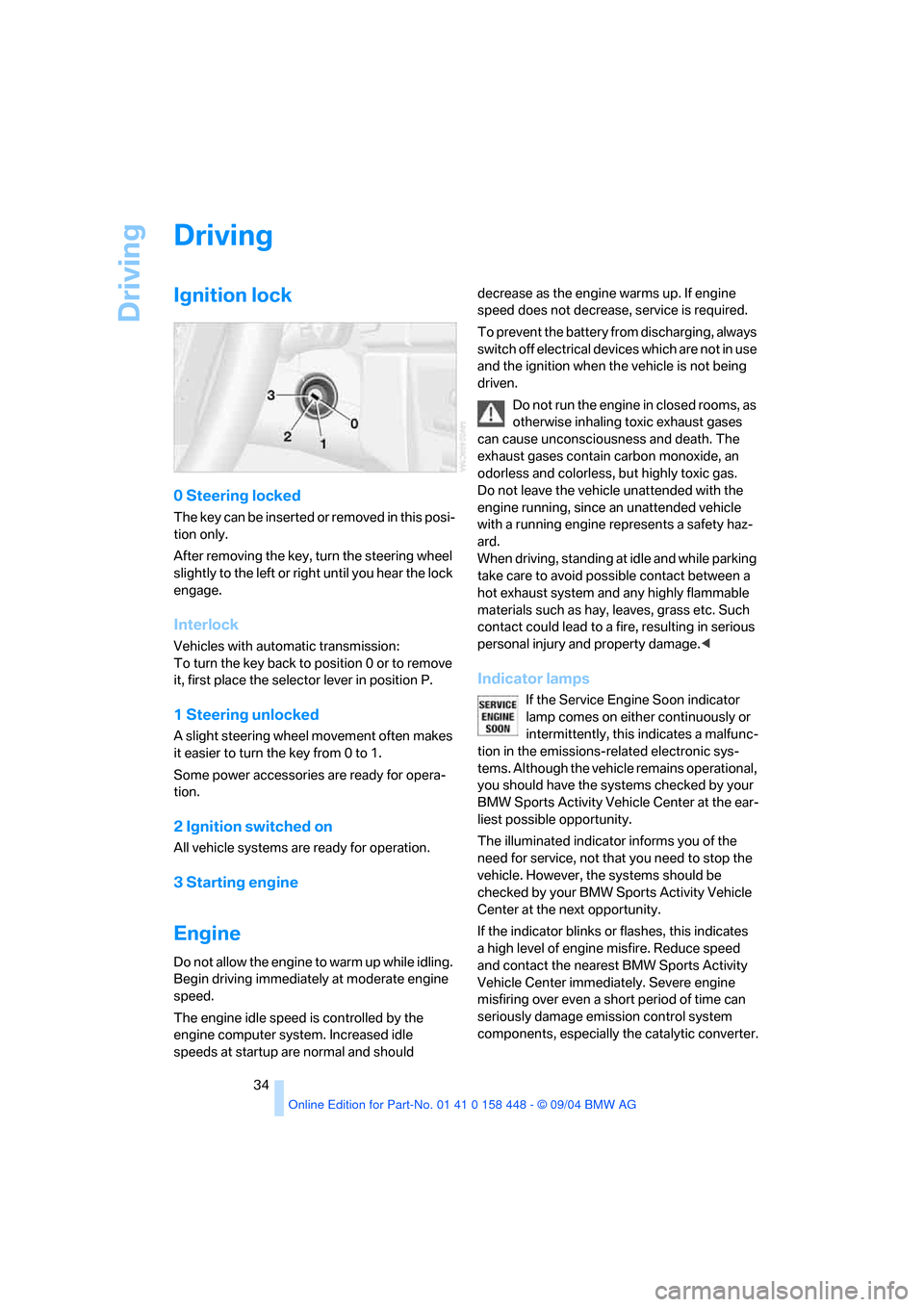
Driving
34
Driving
Ignition lock
0 Steering locked
T h e k e y c a n b e in s e r t e d o r r e m o v e d in t h i s p o s i-
tion only.
After removing the key, turn the steering wheel
slightly to the left or right until you hear the lock
engage.
Interlock
Vehicles with automatic transmission:
To turn the key back to position 0 or to remove
it, first place the selector lever in position P.
1 Steering unlocked
A slight steering wheel movement often makes
it easier to turn the key from 0 to 1.
Some power accessories are ready for opera-
tion.
2 Ignition switched on
All vehicle systems are ready for operation.
3 Starting engine
Engine
Do not allow the engine to warm up while idling.
Begin driving immediately at moderate engine
speed.
The engine idle speed is controlled by the
engine computer system. Increased idle
speeds at startup are normal and should decrease as the engine warms up. If engine
speed does not decrease, service is required.
To prevent the battery from discharging, always
switch off electrical devices which are not in use
and the ignition when the vehicle is not being
driven.
Do not run the engine in closed rooms, as
otherwise inhaling toxic exhaust gases
can cause unconsciousness and death. The
exhaust gases contain carbon monoxide, an
odorless and colorless, but highly toxic gas.
Do not leave the vehicle unattended with the
engine running, since an unattended vehicle
with a running engine represents a safety haz-
ard.
When driving, standing at idle and while parking
take care to avoid possible contact between a
hot exhaust system and any highly flammable
materials such as hay, leaves, grass etc. Such
contact could lead to a fire, resulting in serious
personal injury and property damage.<
Indicator lamps
If the Service Engine Soon indicator
lamp comes on either continuously or
intermittently, this indicates a malfunc-
tion in the emissions-related electronic sys-
tems. Although the vehicle remains operational,
you should have the systems checked by your
BMW Sports Activity Vehicle Center at the ear-
liest possible opportunity.
The illuminated indicator informs you of the
need for service, not that you need to stop the
vehicle. However, the systems should be
checked by your BMW Sports Activity Vehicle
Center at the next opportunity.
If the indicator blinks or flashes, this indicates
a high level of engine misfire. Reduce speed
and contact the nearest BMW Sports Activity
Vehicle Center immediately. Severe engine
misfiring over even a short period of time can
seriously damage emission control system
components, especially the catalytic converter.
Page 36 of 126
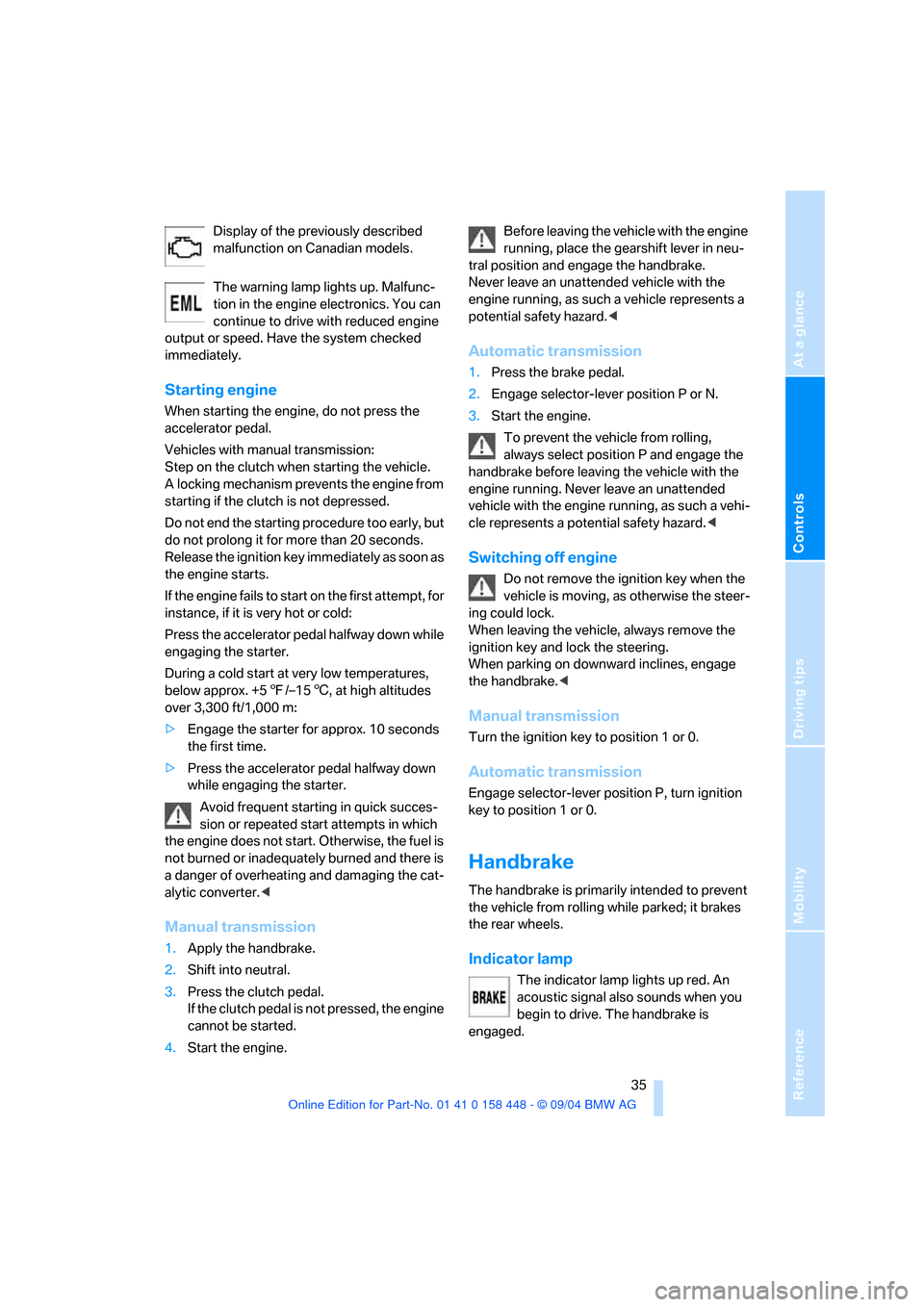
Reference
At a glance
Controls
Driving tips
Mobility
35
Display of the previously described
malfunction on Canadian models.
The warning lamp lights up. Malfunc-
tion in the engine electronics. You can
continue to drive with reduced engine
output or speed. Have the system checked
immediately.
Starting engine
When starting the engine, do not press the
accelerator pedal.
Vehicles with manual transmission:
Step on the clutch when starting the vehicle.
A locking mechanism prevents the engine from
starting if the clutch is not depressed.
Do not end the starting procedure too early, but
do not prolong it for more than 20 seconds.
Release the ignition key immediately as soon as
the engine starts.
If the engine fails to start on the first attempt, for
instance, if it is very hot or cold:
Press the accelerator pedal halfway down while
engaging the starter.
During a cold start at very low temperatures,
below approx. +57/–156, at high altitudes
over 3,300 ft/1,000 m:
>Engage the starter for approx. 10 seconds
the first time.
>Press the accelerator pedal halfway down
while engaging the starter.
Avoid frequent starting in quick succes-
sion or repeated start attempts in which
the engine does not start. Otherwise, the fuel is
not burned or inadequately burned and there is
a danger of overheating and damaging the cat-
alytic converter.<
Manual transmission
1.Apply the handbrake.
2.Shift into neutral.
3.Press the clutch pedal.
If the clutch pedal is not pressed, the engine
cannot be started.
4.Start the engine.Before leaving the vehicle with the engine
running, place the gearshift lever in neu-
tral position and engage the handbrake.
Never leave an unattended vehicle with the
engine running, as such a vehicle represents a
potential safety hazard.<
Automatic transmission
1.Press the brake pedal.
2.Engage selector-lever position P or N.
3.Start the engine.
To prevent the vehicle from rolling,
always select position P and engage the
handbrake before leaving the vehicle with the
engine running. Never leave an unattended
vehicle with the engine running, as such a vehi-
cle represents a potential safety hazard.<
Switching off engine
Do not remove the ignition key when the
vehicle is moving, as otherwise the steer-
ing could lock.
When leaving the vehicle, always remove the
ignition key and lock the steering.
When parking on downward inclines, engage
the handbrake.<
Manual transmission
Turn the ignition key to position 1 or 0.
Automatic transmission
Engage selector-lever position P, turn ignition
key to position 1 or 0.
Handbrake
The handbrake is primarily intended to prevent
the vehicle from rolling while parked; it brakes
the rear wheels.
Indicator lamp
The indicator lamp lights up red. An
acoustic signal also sounds when you
begin to drive. The handbrake is
engaged.
Page 37 of 126

Driving
36 Indicator lamp for Canadian models.
Engaging
The lever engages automatically and the indica-
tor lamp in the instrument cluster lights up from
ignition key position 1.
Releasing
Pull up slightly on the lever, press the button
and lower the lever.
If exceptional circumstances should
make it necessary to engage the hand-
brake while the vehicle is in motion, do not pull it
too strongly. In doing so, continuously press the
button of the handbrake lever. Strong applica-
tion of the handbrake can lead to overbraking of
the rear axle and to associated 'fishtailing' of the
vehicle rear end.
The brake lamps do not light up when the hand-
brake is applied.<
To prevent corrosion and one-sided brak-
ing action, occasionally engage the hand-
brake lightly when the vehicle is slowly coming
to a stop at a traffic light if the traffic conditions
are suitable.<
Manual transmission
When shifting into 5th or 6th gear, make
sure that you press the gearshift lever to
the right to prevent inadvertently shifting into
3rd or 4th.
Do not hold the vehicle in place on slopes by
slipping or riding the clutch. Otherwise greater
clutch wear will result.<
Reverse
Select only when the vehicle is stationary. Press
the gearshift lever to the left to overcome the
resistance.
As you do this, the backup lamps will turn on
automatically when the ignition key is in posi-
tion 2.
Automatic transmission with
Steptronic
In addition to fully automatic operation, you can
also manually shift with the Steptronic, refer to
page37.
Selector-lever positions
P R N D M/S + –
Starting engine
The engine can only be started in selector lever
positions P: Park or N: Neutral.
Page 39 of 126
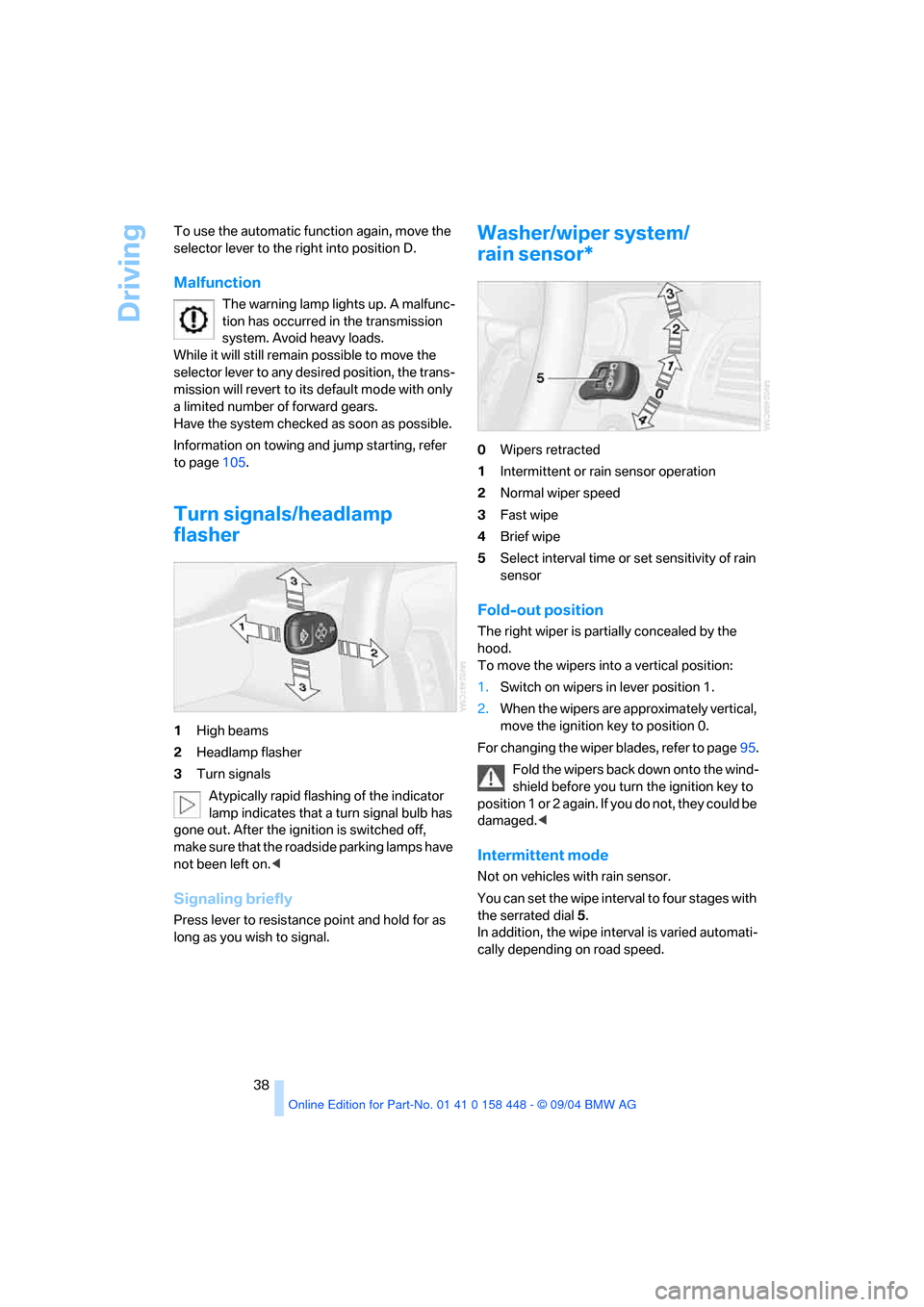
Driving
38 To use the automatic function again, move the
selector lever to the right into position D.
Malfunction
The warning lamp lights up. A malfunc-
tion has occurred in the transmission
system. Avoid heavy loads.
While it will still remain possible to move the
selector lever to any desired position, the trans-
mission will revert to its default mode with only
a limited number of forward gears.
Have the system checked as soon as possible.
Information on towing and jump starting, refer
to page105.
Turn signals/headlamp
flasher
1High beams
2Headlamp flasher
3Turn signals
Atypically rapid flashing of the indicator
lamp indicates that a turn signal bulb has
gone out. After the ignition is switched off,
make sure that the roadside parking lamps have
not been left on.<
Signaling briefly
Press lever to resistance point and hold for as
long as you wish to signal.
Washer/wiper system/
rain sensor*
0Wipers retracted
1Intermittent or rain sensor operation
2Normal wiper speed
3Fast wipe
4Brief wipe
5Select interval time or set sensitivity of rain
sensor
Fold-out position
The right wiper is partially concealed by the
hood.
To move the wipers into a vertical position:
1.Switch on wipers in lever position 1.
2.When the wipers are approximately vertical,
move the ignition key to position 0.
For changing the wiper blades, refer to page95.
Fold the wipers back down onto the wind-
shield before you turn the ignition key to
p o s i t i o n 1 o r 2 a g a i n . I f y o u d o n o t , t h e y c o u l d b e
damaged.<
Intermittent mode
Not on vehicles with rain sensor.
You can set the wipe interval to four stages with
the serrated dial 5.
In addition, the wipe interval is varied automati-
cally depending on road speed.
Page 40 of 126
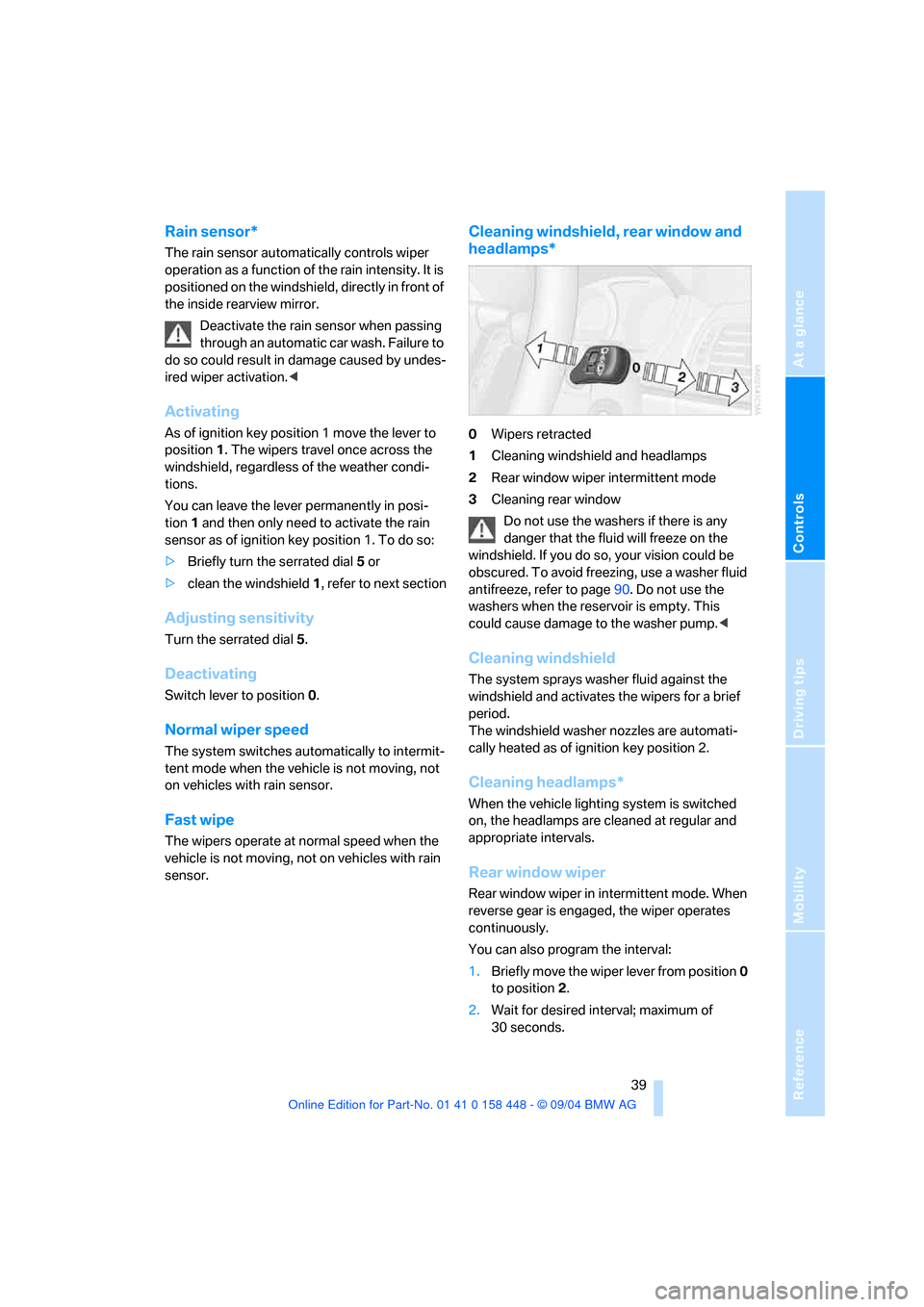
Reference
At a glance
Controls
Driving tips
Mobility
39
Rain sensor*
The rain sensor automatically controls wiper
operation as a function of the rain intensity. It is
positioned on the windshield, directly in front of
the inside rearview mirror.
Deactivate the rain sensor when passing
through an automatic car wash. Failure to
do so could result in damage caused by undes-
ired wiper activation.<
Activating
As of ignition key position 1 move the lever to
position1. The wipers travel once across the
windshield, regardless of the weather condi-
tions.
You can leave the lever permanently in posi-
tion 1 and then only need to activate the rain
sensor as of ignition key position 1. To do so:
>Briefly turn the serrated dial 5 or
>clean the windshield 1, refer to next section
Adjusting sensitivity
Turn the serrated dial 5.
Deactivating
Switch lever to position 0.
Normal wiper speed
The system switches automatically to intermit-
tent mode when the vehicle is not moving, not
on vehicles with rain sensor.
Fast wipe
The wipers operate at normal speed when the
vehicle is not moving, not on vehicles with rain
sensor.
Cleaning windshield, rear window and
headlamps*
0Wipers retracted
1Cleaning windshield and headlamps
2Rear window wiper intermittent mode
3Cleaning rear window
Do not use the washers if there is any
danger that the fluid will freeze on the
windshield. If you do so, your vision could be
obscured. To avoid freezing, use a washer fluid
antifreeze, refer to page90. Do not use the
washers when the reservoir is empty. This
could cause damage to the washer pump.<
Cleaning windshield
The system sprays washer fluid against the
windshield and activates the wipers for a brief
period.
The windshield washer nozzles are automati-
cally heated as of ignition key position 2.
Cleaning headlamps*
When the vehicle lighting system is switched
on, the headlamps are cleaned at regular and
appropriate intervals.
Rear window wiper
Rear window wiper in intermittent mode. When
reverse gear is engaged, the wiper operates
continuously.
You can also program the interval:
1.Briefly move the wiper lever from position 0
to position 2.
2.Wait for desired interval; maximum of
30 seconds.
Page 41 of 126

Driving
40 3.Move the wiper lever from position 0 to
position 2 again
To change the wiper blades, refer to page95.
Cruise control*
The vehicle maintains and stores the speed
that you set as of a speed of approx. 20 mph/
30 km/h.
You can use cruise control whenever the sys-
tem is active while the engine is running.
On the sports steering-wheel
* the buttons +/–
for the cruise control are located on the right-
hand side of the steering wheel.
Indicator lamp
The indicator lamp lights up green:
System ready for operation using the
buttons on the steering wheel.
Activating system
As of ignition key position 2:
Press button on steering wheel; the indicator
lamp in the instrument cluster comes on. You
are able to use the cruise control.
Do not use the cruise control under unfa-
vorable conditions that do not permit a
constant speed, e.g. when driving on winding
roads or in heavy traffic or when negotiating
poor road conditions such as snow, rain, ice, or
a loose road surface.<
Deactivating system
Press the button repeatedly until the indicator
lamp in the instrument cluster goes out.
The cruise control is also deactivated when the
ignition key is turned to position 0. The speed
stored in the memory is deleted in the process.
Maintaining speed, storing, and
accelerating
Briefly press + button:
The system maintains and stores the current
vehicle speed. Every time you briefly press the
button, the vehicle's speed increases by
roughly 1 mph/1 km/h.
Press and hold
+ button:
The vehicle accelerates without pressure on
the accelerator pedal. When you release the
button, the system maintains and stores the
current speed.
If, on a downhill gradient, the engine's
braking effect is not sufficient, the con-
trolled speed can be exceeded. Speed can drop
on uphill grades if the engine output is insuffi-
cient.<
Decelerating
Briefly press – button:
Every time you briefly press the button, the
vehicle's speed decreases by roughly 1 mph/
1 km/h provided that you have already activated
the cruise control.
Press and hold
– button:
With the cruise control active, the system auto-
matically reduces the fuel supply to slow the
vehicle. When you release the button, the sys-
tem maintains and stores the current speed.
Interrupting cruise control
When the system is activated, press button 1.
The indicator lamp stays on. You can use the
cruise control again whenever required by
requesting the speed that was stored last.